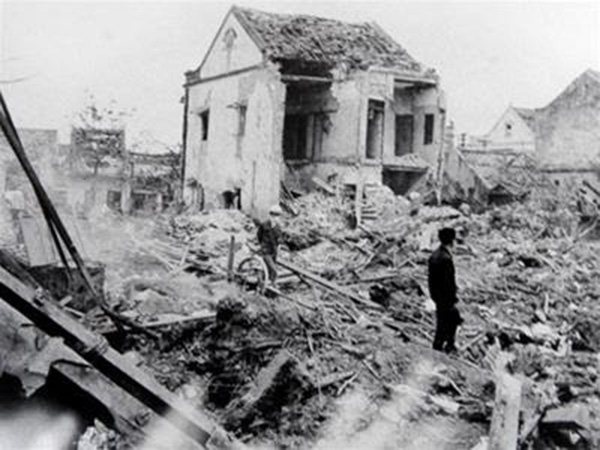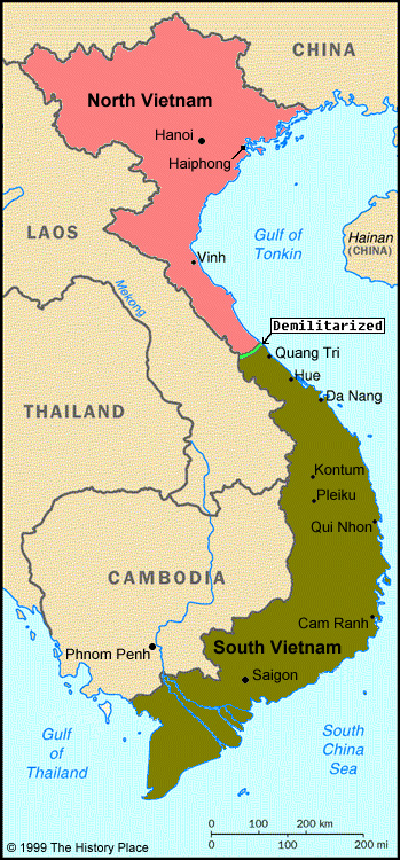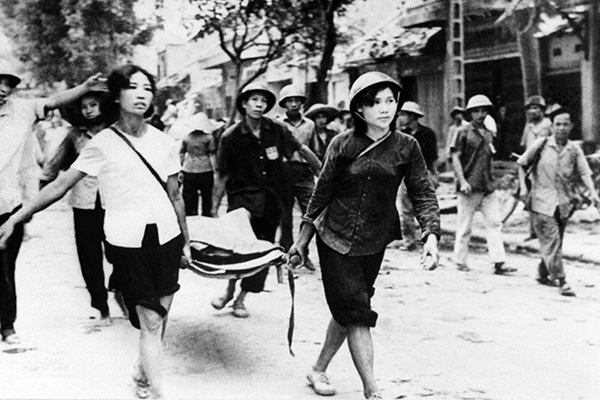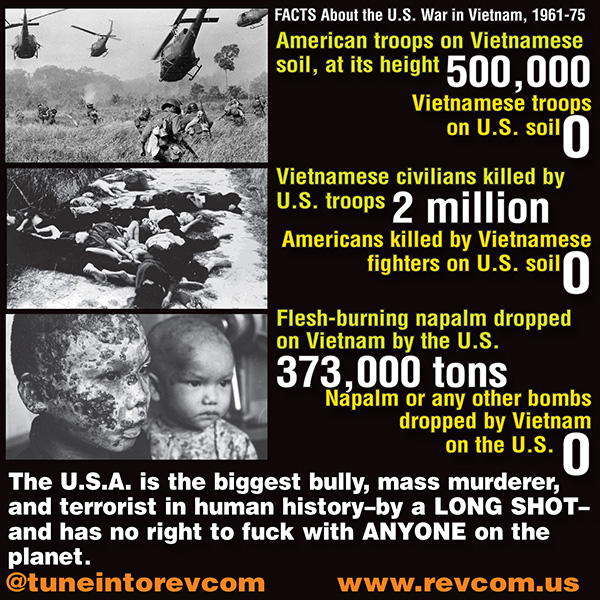Case #34: America’s 1972 Christmas Bombing of North Vietnam
| Revolution Newspaper | revcom.us
Bob Avakian has written that one of three things that has "to happen in order for there to be real and lasting change for the better: People have to fully confront the actual history of this country and its role in the world up to today, and the terrible consequences of this." (See "3 Things that have to happen in order for there to be real and lasting change for the better.")
In that light, and in that spirit, "American Crime" is a regular feature of revcom.us. Each installment will focus on one of the 100 worst crimes committed by the U.S. rulers—out of countless bloody crimes they have carried out against people around the world, from the founding of the U.S. to the present day.
See all the articles in this series.
THE CRIME
The Democratic Republic of Vietnam (called “North Vietnam” by the U.S.), its People’s Army, and the National Liberation Front (NLF) in South Vietnam had been waging a just people’s war for national liberation against the U.S. since 1961 (and before that the Vietnamese had been fighting the French colonialists).1 The U.S. had been bombing the Democratic Republic of Vietnam and the liberation fighters in the south since 1965, but its “Christmas bombing” in 1972 was the most intense and devastating air offensive of the entire war.
For 12 days, from December 18 to 29, U.S. round-the-clock bombing pounded and decimated North Vietnam’s densely populated capital city of Hanoi as well as its nearby seaport and industrial center of Haiphong. Especially targeted and destroyed were radio stations/transmitters, railroads, power plants, docks and shipyards, bridges, petroleum and munition storage depots, and airfields. Along with these targets, which affected North Vietnam’s logistical and war fighting capability, nearby provinces and villages were also bombed. This included bombing some dikes along the Red River delta to flood areas around Hanoi.2 Hospitals, civilian population centers (shopping streets, homes, housing complexes), factories, and diplomatic missions were destroyed as well. Eighty percent of North Vietnam’s electrical power production capacity was demolished.
The massive bombing campaign was code-named Operation Linebacker II. U.S. planes, including the massive, 159-foot-long B-52 bombers, which can carry 70,000 pounds of bombs, and F-111 fighters flew an average of 100 bombing runs a day, raining death and destruction on the Hanoi-Haiphong area day and night. One U.S. pilot casually bragged that “We took off one airplane a minute out of Guam for hours. Just on time takeoff after on time takeoff.”
A wing of Hanoi’s hospital was destroyed by B-52 bombers on December 22. It was North Vietnam’s largest medical facility and research center. Among the dead were 28 doctors, nurses, and pharmacists.
Dr. Nguyen Luan described the scene to Britain’s BBC news:
Cries and moans filled the dark night. We had to use knives, hammers and shovels to break through the concrete walls in order to get to the victims trapped inside. As a surgeon, I operate on people to save their lives. Now I was using my surgical knife not to save people but to cut apart the corpses in the bomb shelter so we could rescue those still alive.
On December 26, the day after Christmas, Hanoi’s large residential and shopping area of Kham Thien was flattened by nearly 100 tons of bombs dropped from B-52s, killing and wounding nearly 600 civilians and destroying 2,000 houses. One resident of the area recounted the horror:
Bombs struck a shelter accommodating 40 inhabitants. I found my wife dead, with only her upper torso left. The bombs pulverized my son, my brother and many others into the soil. Blood and pieces of shredded human flesh remain here and there.
On the evening that the bombings began on December 18, as 129 B-52s roared over Hanoi, 10-year-old Ha Mi watched her friend’s home blown up as she and her sister hid under the stairs of their own home, hearing the B-52 bombers overhead. “Advancing, they were looming, coming towards you with a very low hum. It’s frightening.”
The U.S. government claimed its B-52s dropped about 15,000 tons of bombs in 739 assaults, with another 5,000 tons dropped by other aircraft. However U.S. antiwar veterans’ publications estimated that more than 100,000 tons were dropped, with Hanoi hit by more than 40,000 tons of explosives in the 12 days—the explosive equivalent of the two atomic bombs the U.S. dropped on Hiroshima and Nagasaki in Japan during World War 2. The U.S. government claimed that 1,600 Vietnamese civilians were killed during the Christmas bombing,3 but Vietnamese sources estimate there were 2,300 civilian deaths—about 1,500 in Hanoi alone.
The U.S. declared Operation Linebacker II a big success even as it suffered heavy losses—in planes shot down and pilots captured and killed. While the official U.S. claim is that 11 B-52s were shot down and 11 other aircraft, Vietnamese sources have argued the toll on the U.S. Air Force was significantly greater: that the People’s Army of Vietnam (called the North Vietnamese Army—NVA—by the U.S.) had “...successfully gunned down 81 U.S. aircraft in just 11 days and nights.” America’s “Christmas Bombing” generated worldwide outrage and protests.
Representatives from Sweden and the Vatican compared the Christmas bombings to the kinds of atrocities carried out by the Nazis in WW2.
THE CRIMINALS
President Richard Nixon (1969-1974) ordered Operation Linebacker II, following the same logic that guided him in ordering an earlier bombing raid in 1972: “These bastards have never been bombed like they’re going to be bombed this time.” Nixon even told his secretary of state, Henry Kissinger, that he wanted to use nuclear weapons against North Vietnam’s dikes, saying, “No, no, I’d rather use the nuclear bomb. Have you got that, Henry?” When Kissinger responded he thought that would “just be too much,” Nixon replied, “The nuclear bomb, does that bother you?... I just want you to think big, Henry, for Christsakes.”
Secretary of State Henry Kissinger was a main architect and engineer of the Christmas bombings. He said B-52s were the weapon of choice in Operation Linebacker II because of their “ability to shake the mind and undermine the spirit.”
Presidential military aide General Alexander Haig, who helped plan the operation, argued the U.S. should “strike hard ... and keep on striking until the enemy’s will [is] broken.”
Generals John Dale Ryan, John W. Vogt, Jr., and John C. Meyer were the direct commanders of Linebacker II. The entire U.S. Joint Chiefs of Staff, the pilots and other military personnel who took part in this war crime.
South Vietnam President Nguyễn Văn Thiệu (1967-1975) collaborated with U.S. imperialism against the national liberation struggle in Vietnam, including during the 1972 Christmas bombings.
THE ALIBI
The U.S. claimed the 1961-1975 Vietnam War was being fought to defend free and democratic South Vietnam from an invasion by communist North Vietnam. In 1972, the U.S. was negotiating with the North Vietnamese to bring what Nixon called an honorable end to the war. But when peace talks broke off on December 13, Nixon and Kissinger blamed the North Vietnamese, claiming they had “stalled” and walked out of the negotiations, and then also claimed that bombing them was the only way to force them back to the table and reach a real peace agreement.
Nixon instructed his aides to say the rationale for the Christmas bombing was that “We need to get across the point that the reason for the success of negotiations was the bombing and the converse point that we did not halt the bombing until we had the negotiations back on track.”
THE ACTUAL MOTIVE
The war of liberation being fought by the Vietnamese people of North Vietnam and the National Liberation Front was part of a wave of anti-colonialist, national liberation struggles that swept Asia, Africa, and Latin America during the 1950s, ’60s, and into the ’70s. The U.S. imperialists were determined to crush these struggles and maintain or extend domination over and exploitation of these regions. America’s war in Vietnam was also aimed at encircling revolutionary China, led by Mao Zedong, and contending with the then-imperialist Soviet Union. According to estimates released by the Vietnamese government in 1995, two million Vietnamese civilians and one million soldiers were killed during the war.
The U.S. rulers knew by the mid-1960s that they could not win the war in Vietnam, even as they lied to the public about their great military progress. By the late 1960s, their war losses were mounting, and the war had spawned massive upheaval and protest against the U.S. around the world. By the early 1970s, the antiwar movement in the U.S. had also taken hold among America’s own troops—weakening their morale and fracturing their cohesion, discipline, and fighting ability. During the Christmas bombings, for the first time elite U.S. pilots reportedly rebelled by trashing officers clubs, making antiwar statements, and finding ways to opt out of flying missions. Many did this because they opposed or questioned the bombings; others did so out of a realistic fear of being shot down.
The U.S. rulers were also facing new challenges around the world, in particular from the Soviet Union. Formerly a socialist country, the Soviet Union had by that time restored capitalism and emerged as an an imperialist power, and the U.S.’s main global rival. The Soviets were backing the Vietnamese liberation fighters, and extending their reach around the globe, including by using national liberation struggles to expand their empire.
So the U.S. began withdrawing its troops and secretly began peace talks with the North Vietnamese in 1970, not simply to extricate themselves from Vietnam, but also to reposition themselves globally and take on the Soviet Union.
Those negotiations were near their end stage in December 1972, and the Christmas bombings were aimed at giving the U.S. greater leverage in the talks, crippling North Vietnam militarily, demoralizing the Vietnamese people and robbing them of their will to fight, and to take blood revenge against a people that had defied and defeated them. The U.S. sought to ensure the survival—at least for a period—of their reactionary clients in South Vietnam, and to be able to save face and credibility by claiming they’d achieved an “honorable” end to the war. And the U.S. bombings may well have been aimed at sending a message to the Soviet Union, revolutionary China, and the world, that despite their looming defeat in Vietnam, the U.S. retained both the military capacity and the political will to wreak enormous death and devastation.
The U.S. claimed Operation Linebacker II was a military success, and it may have had some impact on the final peace agreement signed in January 1973. But it didn’t fundamentally change the fact that the agreement mandated the U.S. withdraw all of its troops and advisers and dismantle all its bases in Vietnam. Nor did the Christmas bombings succeed in either destroying North Vietnam’s military or the will of the Vietnamese people to fight on. In April 1975, North Vietnam and the National Liberation Front finally overthrew the pro-U.S. government in the south, finally unified Vietnam, and inflicted a serious defeat on U.S. imperialism.
Sources
“Vietnam Christmas Bombings: 1972 Mutiny of B-52 Crews,” Vietnam Veterans Against the War
“North Vietnam, 1972: The Christmas bombing of Hanoi,” Rebecca Kesby, BBC World Service, December 24, 2012, bbc.com
“The Christmas bombings of Hanoi in retrospect,” Voice of Vietnam, December 29, 2007
“Operation Linebacker II”; “Operation Linebacker”; “1972 in the Vietnam War, Wikipedia
“The War Is Suddenly Grim for the B-52 Fliers on Guam,” Richard Halloran, December 30, 1972, New York Times
“Why the B-52 Failed,” by David Bacon, January 11, 2016, Foreign Policy in Focus
The Vietnam War, a film by Ken Burns and Lynn Novick, Part 9 "A Disrespectful Loyalty" (May 1970-March 1973)
Footnotes
1. The Democratic Republic of Vietnam was founded in 1945 in northern Vietnam under the leadership of Hồ Chi Minh. However, since 1955, South Vietnam had been ruled by reactionaries beholden to the U.S. In 1960, the National Liberation Front, in alliance with North Vietnam, began a guerrilla war in South Vietnam to overthrow its reactionary rulers, drive out U.S. imperialism, and reunite all of Vietnam. [back]
2. The extent of damage to North Vietnam’s dikes is a subject of debate. It appears some dikes were hit during Operation Linebacker II, but the U.S. never carried out an all-out attack on the dikes, which Henry Kissinger estimated could have drowned 200,000 people. [back]
3. The Vietnam War, a film by Ken Burns and Lynn Novick, Part 9 "A Disrespectful Loyalty" (May 1970-March 1973) [back]

For 12 days, from December 18 to 29, 1972, U.S. round-the-clock bombing pounded and decimated North Vietnam’s densely populated capital city of Hanoi as well as its nearby seaport and industrial center of Haiphong.
Clip: "Free Yourself from the GTF!"

See also:
Case #96: Vietnam, March 16, 1968—the My Lai Massacre
THE CRIME: On Saturday morning, March 16, 1968, 100 soldiers from Charlie Company, U.S. Army Americal Division, entered and took over My Lai, a small hamlet in Vietnam’s countryside. “We met no resistance and I only saw three captured weapons.... It was just like any other Vietnamese village—old papa-sans, women and kids,” a soldier said. “The order we were given was to kill and destroy everything that was in the village,” another soldier later testified. Read more
Case #47: The Bombing of Cambodia, 1969-1973
THE CRIME: On the night of March 18, 1969, at the height of the Vietnam War, 60 U.S. B-52 bombers began raining explosives from the skies over Cambodia. A U.S. official said at the time “We had been told ... that those carpet bombing attacks by B-52s were totally devastating, that nothing could survive.”
Thus began America’s first campaign of saturation aerial bombing. It was called “Operation Menu” and for the next 14 months, a total of 3,800 airstrikes of B-52 and F-111 bombers dropped 108,823 tons of explosives on this Southeast Asian country less than half the size of California. Cambodia (and Laos) shared a border with Vietnam, and the Hồ Chí Minh trail (named after the North Vietnamese leader), a military and supply route for the Vietnamese liberation forces, ran through Cambodia. This highly effective military and logistical supply route, and the Vietnamese bases along it, were the main targets of the U.S. bombing. But these were not “surgical strikes”—wide swaths of the lush countryside were obliterated, and the U.S. bombed anything that moved. Read more

Hanoi, 1972, Carrying the dead and injured.

Get a free email subscription to revcom.us:


